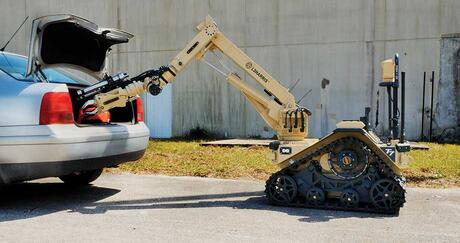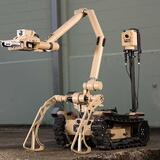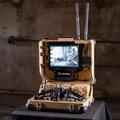Before deciding to procure a robot at face value, it’s important to first look a little deeper into any additional value you might be getting to help inform your choice. For example, a robot might be the most affordable option right now, but you may later discover that it is easily damaged and requires frequent repair, is difficult and time-consuming to repair, or even that it requires heavy amounts of scheduled maintenance, all of which could lead to a significant cost over time. What’s more, with threats evolving at such an astonishing pace, what happens when your robot is no longer fit-for-purpose? It’s critical to ensure any robots you do procure are advanced, robust, and agile enough to maximize mission success, regardless of the environment.
Throughout this article, we’ll be looking at some of the key decision factors that should inform your procurement assessment, seeing you unlock the most possible value out of your investment.
1. Is the robot fit-for-purpose?
The first and most obvious question that needs to be answered is this: does the robot do what you need it to? If the robot’s capabilities sufficiently meet your mission requirements and enable you to successfully and effectively complete your mission objective, then that’s a huge tick in the box. You may even be considering utilizing the robot across multiple mission scenarios, so a system that offers multi-mission capabilities, from explosive ordnance disposal (EOD) to intelligence, surveillance and reconnaissance (ISR) missions, could be an ideal fit. Size, too, is an important consideration – it’s likely your robots will be used in a variety of different environments to achieve different objectives, so understanding which size will offer you the most value should significantly influence your decision.
2. Is it easy to keep in action?
Given the mission scenarios your robots will be tasked with and the dangerous environments they will be working in, a certain degree of robustness, durability and availability is required. At a very minimum, effective robots should be hitting 90 - 95% availability, and preferably the latter to ensure your missions are uninterrupted by sudden faults or failures. It’s also no good investing in a robot that will only make it through two or three missions before being returned to its supplier because a part needs replacing or damage needs to be repaired. Ideally, most repairs should be completed in the field by your own team, being done as far forward as possible to ensure robots are back up and running in the quickest time. Importantly, how much maintenance does your chosen robot need? If regular maintenance is required on a daily or even weekly basis, it’s too much. The most reliable robotic systems on the market will barely need any maintenance at all.
3. How affordable is it?
Procuring robotic systems is a huge investment, so it’s integral to ensure your system is not only affordable upfront, but throughout its whole lifespan. The cost of spare parts for frequent repairs can add up quickly, and can put significant strain on your logistics support system. Additionally, any time lost to repairs, diagnostics and returning to the supplier all result in a cost to productivity and an impediment to mission success. Instead, it’s more advantageous to seek robots that offer exceptional through-life cost, meaning any future upgrades and repairs are completed easily with very little reliance on the manufacturer.
Another large contributor to affordability is training time. Put simply, training is always more cost-effective when the system itself is simple to use. A highly intuitive system means less time spent learning how to operate it, which can lead to significant cost savings and fewer mistakes made during missions. The easier a robot is to use, the smarter the investment.
4. How can I maximize on training?
When it comes to training, it’s always best to ensure your team is aware of the robot’s full scope of capabilities from the get-go. While learning by word of mouth from a peer can be a lot quicker, this can sometimes mean a lot of the robot’s value and potential can be missed or overlooked. Something we’d always suggest our customers look out for when evaluating different robot options is whether the supplier’s robotics experts are willing and available to provide additional coaching after the procurement is completed. If so, you’re getting a lot of additional value from the skills and training top-ups their experts are able to offer, meaning your people gain even further confidence in their ability to correctly operate the robots.
5. Is the robot ready to respond to future threats?
As the threat landscape continues to evolve, what’s increasingly important is ensuring robots are sufficiently equipped to adapt and respond to these changes. The key is to seek flexible, modular systems that can be reconfigured and upgraded, enabling operators to stay ahead of evolving threats. This ease of upgradability also means mid-life improvements can be made to the system without the need for expensive redesigns or retrofit efforts. Parts can simply be swapped out at will and the system reconfigured as needed. Critically, the ability to easily add upgrades in the future extends the useful life of the robots, lowering the total cost of ownership.
Our family of robotic systems achieves all this and more
Our T7™ and T4™ robotic systems are built to a higher build standard than most robots on the market. Incredibly durable, highly intuitive, and purpose-built for challenging commercial and military missions, they tackle dangerous and demanding tasks so humans don’t have to.
Highly robust and durable robots
Our larger T7’s components are designed specifically for longer life, utilizing components originally designed for high-wear applications such as electric vehicle and off-road automotive systems. This means its parts are longer lasting and more rugged than most robots. Built to incorporate any lessons learned from the T7, the T4 is extremely robust as a result, with multiple components able to withstand a lot of abuse and long-term usage. Such features as an automotive-grade track system for all-terrain use, a military-grade battery system that enables high availability, and the ability to fire high-power EOD disruptors repeatedly without damage all add up to long-lasting, reliable systems that keep running until the mission is completed. In fact, during trials for the UK Ministry of Defense’s (MOD) Project STARTER, the T7 considerably exceeded their 90% availability goals and even easily surpassed 95%.
Easy to repair
The vast majority of our robot repairs can be undertaken by our customers, minimizing downtime by avoiding the need to ship the systems back to us. Both systems are incredibly modular in order to ensure repair can be completed as far forward as possible. For example, not only can the T4’s manipulator arm be removed and replaced with no tools, it can be broken down into ten “sub modules” with a single wrench, each of which can be swapped out in the field. Because our robots are so durable, they also require next-to-no preventative maintenance, so very little time is ever lost on routine upkeep.
Intuitive operation, easy training
Our unique intuitive haptic controller makes operating the T7 and T4 feel as natural as moving one’s hand, enabling operators to physically “feel” what the robot arm is doing. This offers unparalleled precision and human-like dexterity during complex tasks, meaning demanding jobs such as unzipping bags and handling fragile chemical vials are completed rapidly, maximizing mission effectiveness. Critically, because the controller is common across both robots, operation is streamlined, cost is reduced and training time is minimized. Operators can even switch between the robots at will, seeing both systems are used simultaneously for integrated missions. This ease of use also results in incredibly high long-term skills retention, so even if a significant amount of time elapses between missions, picking the controls back up is super easy.
Ready for the future
When it comes to being future-ready, the T7 and T4 are highly flexible and modular systems, with mission-specific attachments and payloads available to address different challenges. Many payloads are secured with tool-less quick release mechanisms, ensuring these attachments can be taken on and off frequently and rapidly with ease. Looking ahead, we’re striving to ensure any next-generation kit we design also follows similar principles and utilizes tool-free interfaces wherever possible, meaning future capabilities can be added seamlessly.
Impressive through-life affordability
Designed to take a lot of abuse, our systems are able to handle heavy, long-term usage without breaking. Less damage means fewer spare parts usage and less downtime, and therefore less repair cost. They also require very little maintenance, so there’s no need for frequent lubrication or regular replacing of worn parts. The T7 and T4 have many parts in common, making it a lot easier and cheaper to operate and support a whole fleet. An additional benefit of common parts means these can be stored in less space and more readily distributed to customer sites. The robots’ modular design also supports easy upgrades in the future, improving through-life cost even further. What’s more, our intuitive haptic controller ensures training time and cost is significantly reduced, with the previously mentioned long-term skills retention resulting in significantly less re-training time too.
Robust, flexible, and extremely reliable, our T7 robots are already making a big difference to the UK Ministry of Defence (MOD) as their large robot of choice, and were recently procured by the U.S. Air Force to help mitigate explosive threats at its global bases. Our mid-sized T4 is also being actively trialed and assessed by a number of military and law enforcement agencies all over the world.






